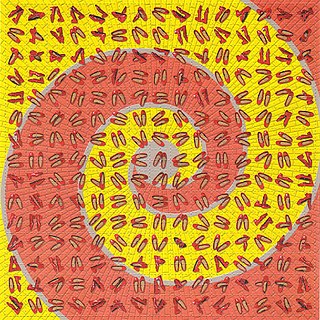Related Research Articles

Lysergic acid diethylamide (LSD), also known colloquially as acid, is a potent psychedelic drug. Effects typically include intensified thoughts, emotions, and sensory perception. At sufficiently high dosages LSD manifests primarily mental, visual, as well as auditory, hallucinations. Dilated pupils, increased blood pressure, and increased body temperature are typical. Effects typically begin within half an hour and can last for up to 20 hours. LSD is also capable of causing mystical experiences and ego dissolution. It is used mainly as a recreational drug or for spiritual reasons. LSD is both the prototypical psychedelic and one of the "classical" psychedelics, being the psychedelics with the greatest scientific and cultural significance. LSD is typically either swallowed or held under the tongue. It is most often sold on blotter paper and less commonly as tablets, in a watery solution or in gelatin squares.

Psilocybin is a naturally occurring psychedelic prodrug compound produced by more than 200 species of fungi. The most potent are members of the genus Psilocybe, such as P. azurescens, P. semilanceata, and P. cyanescens, but psilocybin has also been isolated from about a dozen other genera. Psilocybin is itself biologically inactive but is quickly converted by the body to psilocin, which has mind-altering effects similar, in some aspects, to those of LSD, mescaline, and DMT. In general, the effects include euphoria, visual and mental hallucinations, changes in perception, a distorted sense of time, and perceived spiritual experiences. It can also cause adverse reactions such as nausea and panic attacks.

Project MKUltra was an illegal human experimentation program designed and undertaken by the U.S. Central Intelligence Agency (CIA), intended to develop procedures and identify drugs that could be used in interrogations to weaken individuals and force confessions through brainwashing and psychological torture. It began in 1953, was reduced in scope in 1964 and 1967, and was halted in 1973. MKUltra used numerous methods to manipulate its subjects' mental states and brain functions, such as the covert administration of high doses of psychoactive drugs and other chemicals, electroshocks, hypnosis, sensory deprivation, isolation, and verbal and sexual abuse, in addition to other forms of torture.

Psychedelia refers to the psychedelic subculture of the 1960s and the psychedelic experience. This includes psychedelic art, psychedelic music and style of dress during that era. This was primarily generated by people who used psychedelic drugs such as LSD, mescaline and psilocybin and also non-users who were participants and aficionados of this subculture. Psychedelic art and music typically recreate or reflect the experience of altered consciousness. Psychedelic art uses highly distorted, surreal visuals, bright colors and full spectrums and animation to evoke, convey, or enhance the psychedelic experience. Psychedelic music uses distorted electric guitar, Indian music elements such as the sitar, tabla, electronic effects, sound effects and reverb, and elaborate studio effects, such as playing tapes backwards or panning the music from one side to another.

Psychedelics are a subclass of hallucinogenic drugs whose primary effect is to trigger non-ordinary states of consciousness. This causes specific psychological, visual, and auditory changes, and often a substantially altered state of consciousness. Psychedelic states are often compared to meditative, psychodynamic or transcendental types of alterations of mind. The "classical" psychedelics, the psychedelics with the largest scientific and cultural influence, are mescaline, LSD, psilocybin, and DMT.
A bad trip is an acute adverse psychological reaction to classic hallucinogens. With proper screening, preparation, and support in a regulated setting these are usually benign. A bad trip on psilocybin, for instance, often features intense anxiety, confusion, and agitation, or even psychotic episodes. As of 2011, exact data on the frequency of bad trips are not available.

Psilocybin mushrooms, commonly known as magic mushrooms, are a polyphyletic informal group of fungi that contain psilocybin which turns into psilocin upon ingestion. Biological genera containing psilocybin mushrooms include Copelandia, Gymnopilus, Inocybe, Panaeolus, Pholiotina, Pluteus, and Psilocybe. Psilocybin mushrooms have been and continue to be used in indigenous New World cultures in religious, divinatory, or spiritual contexts. Psilocybin mushrooms are also used as recreational drugs. They may be depicted in Stone Age rock art in Africa and Europe, but are most famously represented in the Pre-Columbian sculptures and glyphs seen throughout North, Central and South America.
Psychedelic therapy refers to the proposed use of psychedelic drugs, such as psilocybin, MDMA, LSD, and ayahuasca, to treat mental disorders. As of 2021, psychedelic drugs are controlled substances in most countries and psychedelic therapy is not legally available outside clinical trials, with some exceptions.

4-Hydroxy-N,N-diisopropyltryptamine is a synthetic psychedelic drug. It is a higher homologue of psilocin, 4-HO-DET, and is a positional isomer of 4-HO-DPT and has a tryptamine molecular sub-structure.

The psychedelic drug lysergic acid diethylamide (LSD) was first synthesized on November 16, 1938, by the Swiss chemist Albert Hofmann in the Sandoz laboratories in Basel, Switzerland. It was not until five years later on April 19, 1943, that the psychedelic properties were found.

2,5-Dimethoxy-4-iodoamphetamine (DOI) is a psychedelic drug and a substituted amphetamine. Unlike many other substituted amphetamines, however, it is not primarily a stimulant. DOI has a stereocenter and R-(−)-DOI is the more active stereoisomer. In neuroscience research, [125I]-R-(−)-DOI is used as a radioligand and indicator of the presence of 5-HT2A serotonin receptors. DOI's effects have been compared to LSD, although there are differences that experienced users can distinguish. Besides the longer duration, the trip tends to be more energetic than an LSD trip, with more body load and a different subjective visual experience. The after effects include residual stimulation and difficulty sleeping, which, depending on the dose, may persist for days. While rare, it is sometimes sold as a substitute for LSD, or even sold falsely as LSD, which may be dangerous because DOI does not have the same established safety profile as LSD.
A psychedelic experience is a temporary altered state of consciousness induced by the consumption of a psychedelic substance. For example, an acid trip is a psychedelic experience brought on by the use of LSD, while a mushroom trip is a psychedelic experience brought on by the use of psilocybin. Psychedelic experiences feature alterations in normal perception such as visual distortions and a subjective loss of self-identity, sometimes interpreted as mystical experiences. Psychedelic experiences lack predictability, as they can range from being highly pleasurable to frightening. The outcome of a psychedelic experience is heavily influenced by the person's mood, personality, expectations, and environment.
The Multidisciplinary Association for Psychedelic Studies (MAPS) is an American nonprofit organization working to raise awareness and understanding of psychedelic substances. MAPS was founded in 1986 by Rick Doblin and is now based in San Jose, California.

Oscar Janiger was an experimental psychiatrist and a University of California Irvine psychiatrist and psychotherapist, best known for his LSD research, which lasted from 1954 to 1962.

A drug is any chemical substance that causes a change in an organism's physiology or psychology when consumed. Drugs are typically distinguished from food and substances that provide nutritional support. Consumption of drugs can be via inhalation, injection, smoking, ingestion, absorption via a patch on the skin, suppository, or dissolution under the tongue.

The drug policy in the United States is the activity of the federal government relating to the regulation of drugs. Starting in the early 1900s the United States government began enforcing drug policies. These policies criminalized drugs such as opium, morphine, heroine, and cocaine outside of medical use. The drug policies put into place are enforced by the Food and Drug Administration and the Drug Enforcement Administration. Classification of Drugs are defined and enforced using the Controlled Substance Act, which lists different drugs into their respective substances based on its potential of abuse and potential for medical use. Four different categories of drugs are Alcohol, Cannabis, Opioids, and Stimulants.
Many urban legends and misconceptions about drugs have been created and circulated among young people and the general public, with varying degrees of veracity. These are commonly repeated by organizations which oppose all classified drug use, often causing the true effects and dangers of drugs to be misunderstood and less scrutinized. The most common subjects of such false beliefs are LSD, cannabis, and MDMA. These misconceptions include misinformation about adulterants or other black market issues, as well as alleged effects of the pure substances.
Hallucinogens are a large, diverse class of psychoactive drugs that can produce altered states of consciousness characterized by major alterations in thought, mood, and perception as well as other changes. Most hallucinogens can be categorized as either being psychedelics, dissociatives, or deliriants. However, certain hallucinogens such as Fly agaric as well as other gabaergic hallucinogenics are more often considered to technically be hypnotics, therefore indicating another separate subcategory of drugs which can substantially alter visual perception.

A psychoactive drug, psychopharmaceutical, psychoactive agent or psychotropic drug is a chemical substance, that changes functions of the nervous system, and results in alterations in perception, mood, consciousness, cognition or behavior.
Sidney Cohen, MD was a psychiatrist, professor of medicine, and author, known as a leading expert on LSD, marijuana, cocaine, and other mood altering drugs.
References
- 1 2 3 4 Nowlis, Helen H. (December 1967), Drugs on the College Campus. A Guide for College Administrators. (PDF), Detroit, Mich.: National Association of Student Personnel Administration / sponsored by Food and Drug Administration (DHEW), Washington, D.C., p. 111
- ↑ Paul A. Pumplan, Director, FDA Office of Legislative and Governmental Services (1873), "Letter to Senator Carl Curtis", Congressional Record , United States Government Printing Office, vol. 113: Cong. 90 Sess. 1 - Parts 13-14 – via Internet Archive
{{citation}}: CS1 maint: multiple names: authors list (link) - 1 2 Jenks, Shepherd M.; Buchanan, David; Montagne, Michael; Smith, Elvin D. (1979), Bunce, Richard (ed.), "Social and Political Sources of Drug Effects: The Case of Bad Trips on Psychedelics", Journal of Drug Issues , 9 (2): 227, doi:10.1177/002204267900900207, S2CID 148534515
- ↑ The Mind - Benders: Lysergic acid diethylamide (LSD) and the Hallucinogens at the National Archives and Records Administration
- ↑ The Federal effort against organized crime: Hearings, Ninetieth Congress, first session, Part 2, Government Printing Office, 1967, p. 316
- ↑ Hearings, Reports and Prints of the Senate Committee on the District of Columbia, United States Government Printing Office, 1970, p. 1688
- ↑ Blakeslee, Alton L. (1969), What you should know about drugs and narcotics, Associated Press, p. 47
- ↑ Healy, Patrick F.; Manak, James P. (1971), "How to plan a drug-abuse workshop", Drug dependence and abuse resource book, National District Attorneys Association, p. 271
- ↑ Drug Abuse for Junior and Senior High School: Science Portion of District Curriculum Guide, San Jose Unified School District, 1969, p. 145